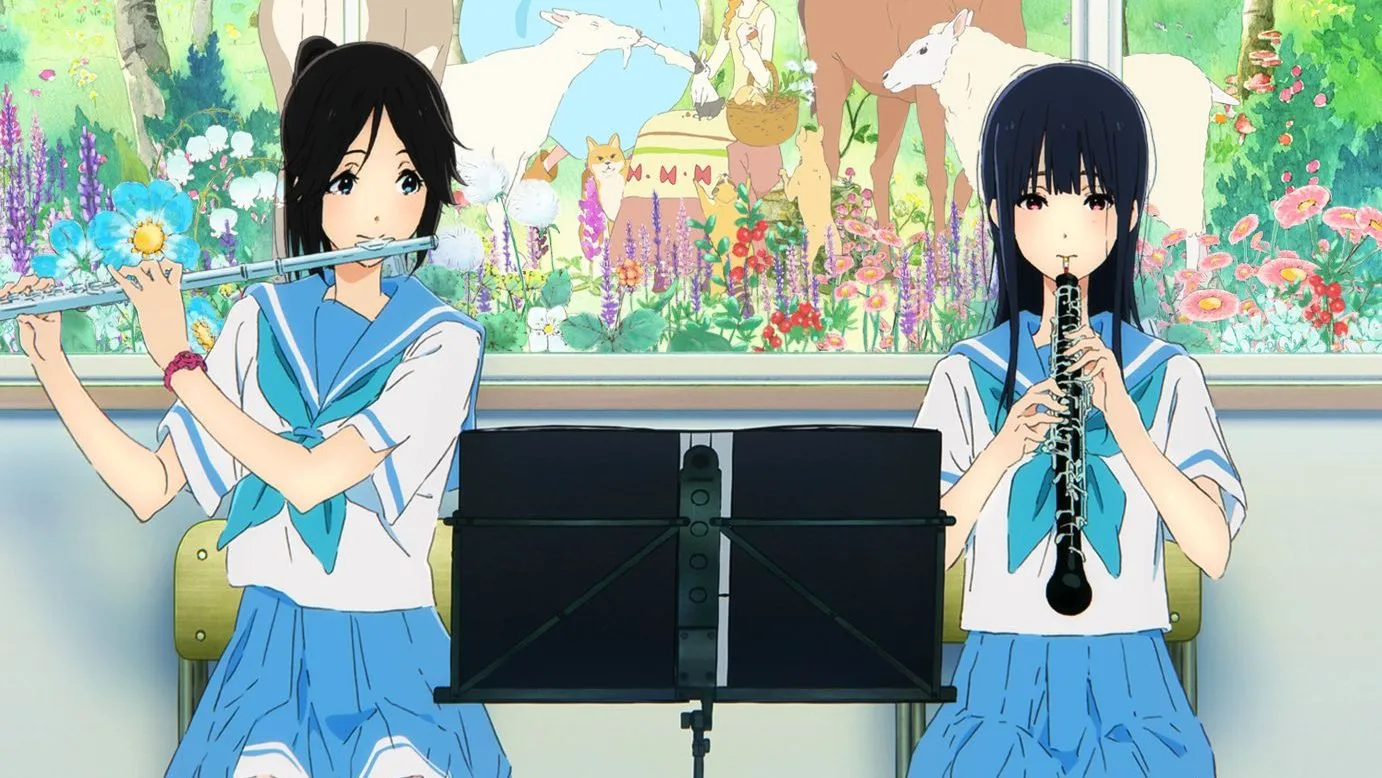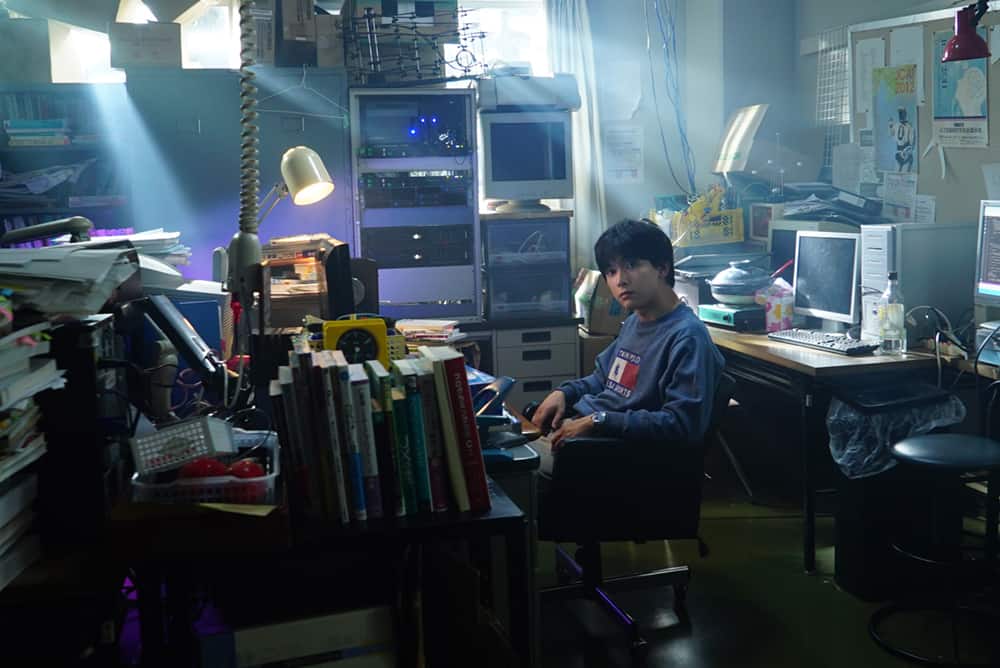by Sarah Miles
After the massive critical and commercial success of “A Silent Voice” (2016), it seemed like director Naoko Yamada could do no wrong and was poised for huge things. It may have been strange for some then that her next directorial project would be tied to the “Sound! Euphonium” anime series, which Yamada had previously worked on as series unit director under Tatsuya Ishihara. It could almost be seen as a regression, as Yamada's first two features, “K-on! The Movie” (2011) and “Tamako Love Story” (2014), were also based on pre-existing anime series. Yet whether a fan of “Sound! Euphonium” or not, “Liz and the Blue Bird” (2018) is a constant delight and could well be Yamada's masterpiece.
Watch This Title on Crunchyroll
by clicking on the image below
Mizore Yoroizuka and Nozomi Kasaki are close friends, bandmates, and entering their third and final year of highschool. They are a pair of opposites, as Mizore is shy, quiet, and introspective, while Nozomi is outgoing, upbeat, and has no trouble navigating social situations. The school concert band's competition piece for this year is Liz and the Blue Bird, based on a fairytale of a lonely girl who befriends a magical bluebird that transforms into a person but the two eventually must part ways. Mizore and Nozomi are performing a solo as part of the piece, which sees Mizore's oboe playing the part of Liz and Nozomi's flute as the bluebird. As the two practise they must also confront their feelings for each other and their respective futures once the school year ends.
“Liz and the Blue Bird” is a film that is very much low on stakes, but the characters and the power of the emotions makes it undeniably compelling. This is a work of subtlety and complex emotions expressed with absolute delicacy. Much is articulated in the moments where nothing is being said, and there are many layers at play in the two girl's relationship. Yamada's lack of fear to let silence sit means that the audience can really soak up and appreciate those moments and nuances.
The decision to place events almost entirely within the school is an interesting one. Its main effect is that it strips things to its barest and most important elements; school is where Mizore and Nozomi first met and have the bulk of their interactions. It is also where the band is based which is the crux of the girls' lives and possible futures. This is balanced by the storybook sequences which are done in a watercolour painted illustration style. These moments serve to be both a burst of colour compared to the muted realist tones in the rest of the film and works as a thematic undercurrent to reflect the main plot. It would be easy to draw parallels between the lonely Liz and Mizore and the bright bluebird and Nozomi, and even the girls themselves comment on it, but the reality is far more complicated and nuanced than that. Mizore has attached herself to Nozomi as the first person to take an interest in her and wants to keep her close, and as such cannot comprehend the decisions of Liz letting the bluebird go, whereas Nozomi takes Mizore's presence for granted without much thought for what effect her actions could have on the other girl. It's a kind of push-pull unequal co-dependency, and one that stifles both.
With a film that is based on an anime series, there might be worries for some that a pre-existing familiarity with the material is necessary. That is absolutely not the case here and one could walk into this having never heard of “Sound! Euphonium” and still get the same experience. Any references to the main series almost feel like Easter Eggs rather than any major element that impacts “Liz and the Blue Bird”. The only moment that happens that could benefit from knowledge of the series is when Kumiko and Reina, the main characters of the series, play Mizore and Nozomi's duet and it contrasts to their playing by how much more in sync they are. However, you still get the importance and significance of that moment even without the knowledge of who Kumiko and Reina are and how their own relationship has developed. So whilst there are little extra things for fans of the anime to pick up on it is immaterial to enjoying this film as it is.
Whilst the bulk of director Yamada's storytelling is in the small silent moments, that does not in any way detract from the strength of veteran screenwriter Reiko Yoshida's script, nor the efforts of the voice cast. All characters are voiced with a natural sensitivity, feeling real and whole no matter how big or small a role they have. Yet unsurprisingly Atsumi Tanezaki as Mizore and Nao Toyama as Nozomi are the impeccable heart of the cast and bring such life to the girls.
Unsurprisingly for a Kyoto Animation production, every moment of “Liz and the Blue Bird” is a gorgeous feast for the eyes. The locations are beautifully realised; sharp and clear in a way that makes you feel you could walk into them and feel the changing of the seasons that are seen on screen. Yet there is an emptiness to them that speaks of liminal time and the temporariness facing Mizore and Nozomi as their school life is coming to a close. In contrast to these environments are the fairytale sequences which manage to look picturesque and dreamy simultaneously. The real achievement in the animation though is in its characters, designed by Futoshi Nishiya. Every little micro expression, movement, and reaction add volumes to the nonverbal storytelling on display here, and even at times say the real meaning behind spoken dialogue.
“Liz and the Blue Bird” has two composers. Kensuke Ushio, who had previously scored “A Silent Voice”, composed the school sequences. By blending things like the characters' footsteps into the music Ushio gives a sense of life to the minimalist score that feels like a natural extension of the scenes. Akito Matsuda, who composed and conducted the music for the “Sound! Euphonium” series, worked on the fairytale segments and band performances. It works really well as whilst each style is distinctly different, they match their respective sections so well that you don't notice.
There is just so much to fall in love with Naoko Yamada's work, and that is very much the case here in “Liz and the Blue Bird”. Yamada understands emotional storytelling in a way that puts the audience right in the heart of what the characters are experiencing. When that is combined with smooth and beautiful animation and a score that matches that animation so well you have an experience that is a joy from beginning to end. “Liz and the Blue Bird” is nothing less than food for the soul.

















